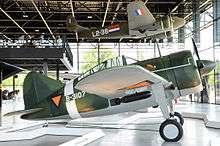Gerard Bruggink
| Gerardus Meinardus Bruggink | |
|---|---|
| Born |
4 August 1917 Tubbergen, Netherlands |
| Died |
5 December 2005 Skipperville, Alabama, United States |
| Allegiance | Netherlands |
| Years of service | 1939-1955 |
| Rank | 1st Lieutenant |
| Unit | 2-VLG-V |
| Battles/wars |
Battle of Malaya Battle of Java |
| Awards |
Bronze Cross (subsequently rescinded[1]) Airman's Cross Knight 4th class of the Military William Order[2] |
| Other work | Flight instructor, Accident investigator[3] |
Gerardus Meinardus Bruggink (4 August 1917 – 5 December 2005) was a Dutch pilot of the Royal Netherlands East Indies Army Air Force. A recipient of the Military Order of William, he was one of only four Dutch pilots to dogfight the Japanese in the Battle of Java.[2]
Born in Tubbergen, Overijssel, Bruggink followed a Catholic seminary. He met his wife, Corien, while serving in the Dutch East Indies and they were married in January 1942.[2] A replica B-339C Brewster Buffalo (B-3107) was built in July 2008 and delivered to the National Military Museum in Soesterberg, Netherlands, carrying the markings of the plane flown by Bruggink.[4]
Military William Order flight
Bruggink, along with Lt. August Deibel and Officer Cadet Jan Scheffer, volunteered to join Capt. Jacob van Helsdingen on his mission using the last three working Buffalo aircraft on Andir airfield. The four pilots took off on March 7, 1942 and proceeded to Lembang to provide air support for ground troops fighting the Japanese in the city.
Helsdingen's squadron travelled 200 kilometers when they encountered a Japanese aircraft, which Deibel attacked before it escaped. Some time later, three Japanese A6M Zeros appeared. Deibel fired at two of them which turned away, but was hit in the oil tank by the third Zero and had to break off from combat. His wingman, Jan Scheffer escorted him back to Andir airfield under a tropical rainstorm, where Deibel crashed landed his aircraft without suffering any injuries. Helsdingen and Bruggink remained above Lembang, but were now dogfighting six Zeroes. Helsdingen was soon shot down, but Bruggink managed to escape into the clouds before returning to Andir airfield. Dutch forces in Lembang surrendered the next day. All four Dutch pilots were awarded the Military William Order on July 14, 1948.[1] Bruggink also received the Airman's Cross.
Later life

After the Dutch East Indies surrendered, Bruggink became a prisoner of war and was forced to work on the infamous Burma Railway, while his wife was interned in a camp in Java. They were reunited in December 1945, after the war.[2]
In 1955, Bruggink left the air force and emigrated with his family to the United States, where he worked as a flight instructor for civil aviation in Texas.[2] In 1959, Bruggink started working for various research organizations, including the National Transportation Safety Board, inspecting aircraft incidents and air safety before retiring in 1982.[3] He died in his home in Skipperville, Alabama, on 5 December 2005, after a long illness.[2] He was 88 years old.[2]
See also
References
- 1 2 Bruggink was originally awarded an Honorable Mention and the Bronze Cross, but Dutch rules only permit one award for a single brave act so these were subsequently rescinded and replaced by the Military William Order.
- 1 2 3 4 5 6 7 Gerry Bruggink Goes ‘West’ (PDF), Ron Schleede, Vice-President, retrieved 2010-01-24
- 1 2 Pilot in Command, Paul A. Craig, retrieved 2010-01-24
- ↑ Some Buffalo bits in Holland